Immerse yourself in Barcelona's vibrant flavors and uncover hidden culinary gems with our expert insider guides. Plan an unforgettable trip today!
Read more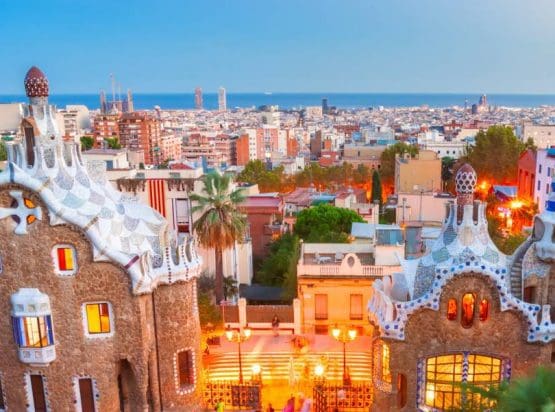
EXPLORE ALL OUR CATALUNYA WINE REGIONS GUIDE
Last updated: October 11, 2024
The wine country of Penedès, located less than an hour from Barcelona, is one of the most exciting destinations in Spain. This is the birthplace of Cava and a Mecca for exceptional dry reds, whites, and pungent dessert wines. Some of Spain’s most iconic brands make their home in the area centered on the towns of Sant Sadurni d’ Anoia and Vilafranca del Penedès. It was also one of the first regions in Spain to embrace international varieties, thanks to the pioneering work of the Torres family. More recently, this impressive outfit has become a world leader in sustainability, adopting green energy production at their wineries throughout Catalunya. Dynamic, progressive, innovative: Penedès represents the best of Spanish winemaking.
Discover more about Spanish Wine
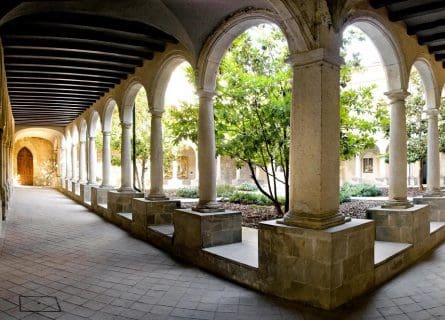
Penedès is a fascinating region steeped in history and renowned for its “Modernista” (similar to Art Nouveau) architecture from geniuses such as Gaudi, Cadalfach, and Domenech I Montaner. However, its significance as a major center of wine production stretches back to the ancient Romans. This civilization left many vestiges of their wine production here (some of which you can see in the little wine museum in Vilafranca del Penedès, one of the principal wine villages along with Sant Sadurni d’Anoia). Indeed, the vine flourished in eastern Spain for centuries, producing some of the Roman Empire’s finest drops.
However, the Dark Ages (the period following the collapse of the Western Roman Empire in 476) saw wine growing all but disappear from daily life in Catalunya. Several rival powers staked their claim on this irresistible piece of Mediterranean real estate, including the Franks and Visigoths. The latter established a short-lived capital in the beautiful city of Toledo in the early 7th century. However, the Visigothic ruling class only numbered a few hundred thousand set against a population of several million.
Nevertheless, they remained the ruling class – much aided by the Hispano-Roman upper classes and Christian clergy. This alliance disintegrated, however, after the Muslim forces of Tariq invaded southern Spain in 711. By 718, Penedès was under Moorish control and briefly subsumed into the kingdom of Al Andalus, much respected by modern historians for its numerous achievements in science, engineering, and architecture. Yet the forces of Tariq struggled to control the fiercely independent Catalans; the region was liberated less than a hundred years after the Moors invaded Catalunya.
Catalan Nobility’s Ascendancy
By 801, they had been vanquished from Barcelona, and the region was under the stewardship of the counts: Catalan nobility related by family ties. Under the charismatic ruler Ramon Berenguer, Tarragona was retaken in the 12th century, and Catalunya launched its own naval fleet. He subsequently married the heiress to the territory of Aragon in 1137, laying the groundwork for an eventual union with Castile in the 15th century. However, the Middle Ages were a period of great revival for Catalunya’s once-ailing wine industry, as the monasteries assumed responsibility for wine growing throughout Western Europe. By the 1400s, the wines of Penedès were the toast of the Spanish court.
Unfortunately, Catalunya stumbled from one disaster to another in the 1700s. After Carlos II, the last of the Habsburgs, died in 1700, the crown passed to the autocrat Felipe V – a devotee of French-style absolutism and centralism. He abolished Catalunya’s parliament, the Generalitat, built a massive fort to watch over Barcelona, and prohibited writing and teaching in Catalan.
However, some national pride was restored after Catalunya became Spain’s first region to industrialize properly, with shipbuilding, wine, and textile industries thriving in the 18th century. Penedès was at the forefront of this economic boom, producing a range of wines that started to include sparkling Cava in the 1800s.
The 20th century was no less of a roller coaster. General Francisco Franco emerged triumphant during the Spanish Civil War of the 1930s, crushing political opponents and abolishing regional independence during his reign in the mid-1900s. Thankfully, the transition to democracy in the 1970s was relatively painless, and investment started to flow into regions like Penedès, attracting pioneers like the Torres family.
Today, many internationally famous brands and important wineries are located in the Penedès, such as Miguel Torres and Jean Leon. Torres is one of the Spanish trailblazers of the Spanish industry and is responsible for groundbreaking research on the Catalan grape varietals. In addition, Spain’s finest sparkling wine houses all make their home in the vineyards of Penedès, including Raventos i Blanc, Gramona, Pares Balta, and Recaredo.
Meanwhile, Henkell-Freixenet and Codorniu are among the world’s largest producers of sparkling wine, boasting exceptionally beautiful wine cellars dating to the 1800s. Modern Penedès is a viticultural powerhouse.
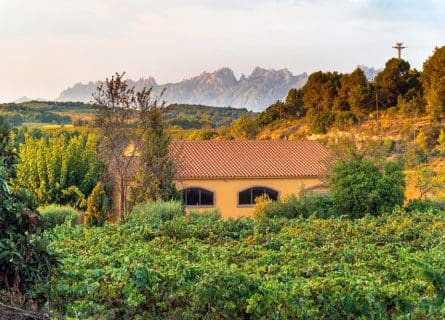
Situated west of Barcelona are the vineyards of Penedès, drenched in year-round Mediterranean sunshine. So, one might expect a deluge of ripe, fruity wines for immediate consumption, which are easy to drink and forget. Yet the flavors and styles produced in this diverse region run the whole gamut, from aromatic sparkling wine to elegant Pinot Noir and voluptuous Merlot. This is made possible by the wonderfully varied topography of the zone; elevation and aspect are key determinants of wine style in Penedès.
There are two mountain ranges and a valley in the middle of the appellation, with certain sites rising to over 750 meters above sea level. The net result is a plethora of mesoclimates and soil types (including clay, limestone, and sand) divided into three distinct subzones: Baix Penedès, Alt Penedès, and Medio Penedès.
Baix Penedès
The low-lying vineyards of Baix Penedès are easily reachable from Sitges, one of Catalunya’s most fashionable and charming summer resorts. The vineyards are found west of the city, chartering a path that includes the coastal town of Calafell and the village of Llorenç del Penedès, situated further north. An eclectic palate of grape varieties thrives in this favored terroir, although the warmer mesoclimate is conducive to ripening styles like Syrah and Grenache.
Alt Penedès
However, most of the wineries we work with are located in the Alt Penedès, where diurnal temperature variation offers real advantages to growers who cultivate vines in these high-altitude climats. It explains the astonishing volume of fresh and elegant whites you’ll encounter here; the Tramontana wind, which blows in from France during winter, is subdued by the Montserrat mountains, which rise majestically above the wine country.
Medio-Penedès
With such a wide range of terrains, the Penedès is full of mesoclimates, which talented winemakers take advantage of to produce high-quality and varied wines. The vineyards of Medio-Penedès fill an expansive valley, with elevation ranging from 250 to 500 meters above sea level. Many Cava firms source their grapes from this subzone.
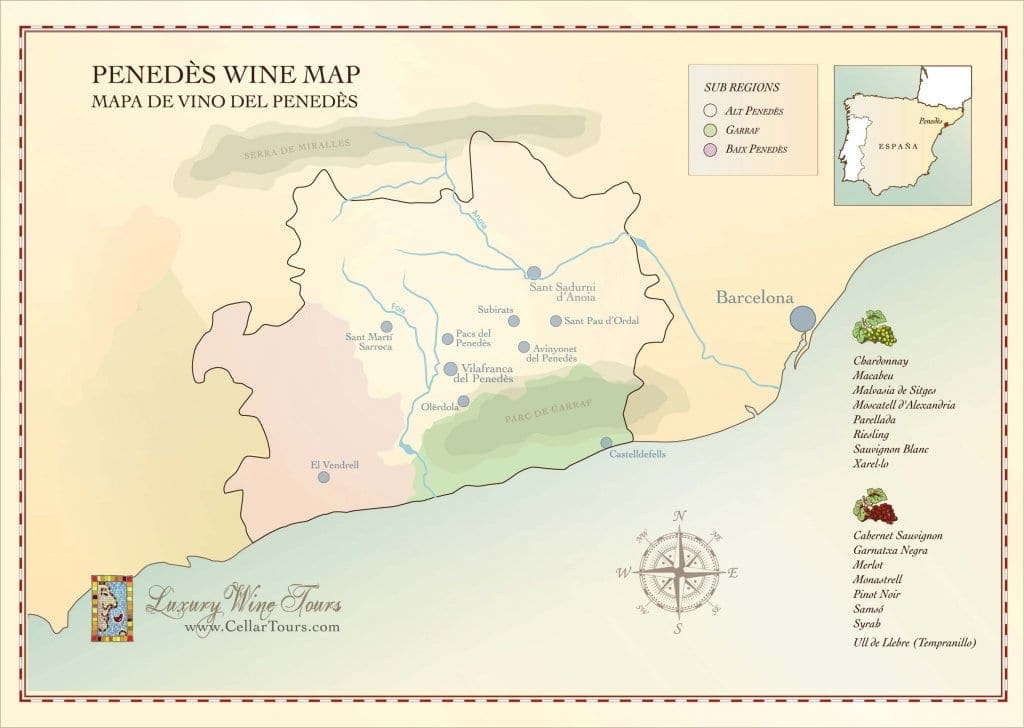
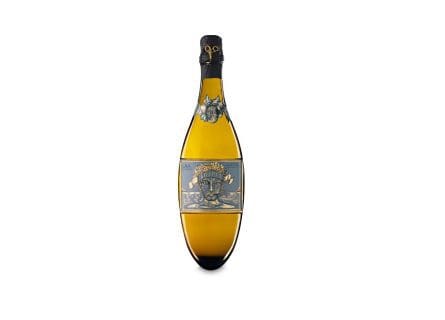
A tremendous amount of grape varieties are grown in Penedès. It is arguably one of Spain’s most progressive DOs, having long welcomed international styles like Chardonnay and Merlot – an anathema to other appellations and winemakers in the country. Founded in 1960, the DO covers red, white, and rosé wines that are difficult to pin down. It’s all here: light and unoaked Sauvignon Blanc, barrel-fermented Xarel-lo, Pomerol-like Merlot, and exceptional Cabernet Sauvignon from Torres’ Mas La Plana vineyard.
The Torres family was one of the first to introduce modern equipment and French varieties to Catalunya in the mid-20th century. However, they are also committed to championing ancient Catalan grapes like the red-skinned Trepat. There is no ‘typical’ wine from Penedès, not least because attitudes and approaches to winemaking vary dramatically.
Cava: Spain’s Premier Sparkling Wine
The same could be said of Cava; over 95 percent of Spain’s premier bubbly is made in Catalunya, mainly from the vineyards on a plateau surrounding Sant Sadurni d’Anoia. From one perspective, Cava is ‘Spanish Champagne’ – it uses the traditional method developed in northeastern France in the 18th century. Yet despite the encroachment of Pinot Noir and Chardonnay, most growers use Spanish grapes – Macabeo, Xarel-lo, and Parellada – to make their sparkling wine. Thus, most Cava bears very little resemblance to Moet & Chandon and Krug: the fruit is riper, and the flavors have a spicier edge, with fennel and herbaceous notes much in evidence.
But, like Champagne, there are many categories, including white, rosé, vintage, NV, and zero-dosage Cava. Single-vineyard bottlings are currently in vogue, too, sold as ‘Cava de Paraje Calificado.’ The DO introduced this new tier in 2016 to improve Cava’s reputation. So far, it appears to be working.
Yet there is plenty of competition in the vineyards of Penedès. In 2014, DO Penedès introduced a separate category known as Clàssic Penedès. The regulatory framework goes above and beyond Cava: wines must be aged for at least 15 months before release, and only organically grown fruit can be used. However, the newest member of this expanding club is Corpinnat, an appellation established in 2019 by ex-Cava winemakers Xavier Gramona, Ton Mata, and others. Their self-imposed rule book is among the most stringent in Spain, producing long-aged sparkling wines that can slay Champagne in blind tastings.
Penedès is changing. New styles, subregions, and categories have emerged while investment in sustainable wine growing continues at a lightning pace. Climate change is partly responsible for this hive of activity, as producers seek cooler terroirs and grape varieties that can cope with the increasingly torrid summers and scant rainfall.
Torres had invested in renewable energy sources and reduced carbon footprint, but other trailblazers like Codorniu are not far behind. But most important is Cava’s transformation; the DO has embraced new zoning and classification regulations designed to jolt this troubled ‘brand’ out of its inertia. Cava can certainly offer excellent value: bodegas like Juve y Camps and Codorniu produce very high-quality sparkling wines at attractive prices.
Nevertheless, the category’s image has battered recently, as consumers move across to Prosecco and the ‘cheap and cheerful’ epithet stubbornly persists. Consejo’s initiatives won’t work miracles, but they are an important and positive step in the right direction.
“The Only Thing That Is Constant Is Change,” observed the Greek philosopher Heraclitus. It’s a life lesson that few winemakers in Catalunya need to learn.
Chardonnay is a green-skinned grape varietal native to the Burgundy wine region in France and one of the most popular varieties worldwide.
Find out moreChenin blanc is a white wine grape varietal from France's Loire Valley Wine Region. It's a highly versatile grape that produces delicious, light-bodied wines.
Find out moreDiscover Viura: Rioja's Prominent White Grape & Catalonia's Macabeo. Explore its versatility in exquisite wines. A must-read for wine enthusiasts.
Find out moreUnveil the allure of Parellada grape: a Spanish gem crafting elegant sparkling & white wines. Explore its unique qualities & flavor profile.
Find out moreThe sauvignon blanc grape varietal, originally from the Bordeaux region of France, is now one of the world's most loved white varieties.
Find out moreDiscover Riesling's charm, a white grape from Germany's Rhine region, cherished in Alsace, France. Unveil its secrets and delights
Find out moreUnveiling Xarel-lo: A Key Grape in Catalonia's Cava Sparkling Wine. Discover the Intriguing Role of Xarel-lo in Spain's Sparkling Delight.
Find out moreDiscover the irresistible allure of Cabernet Sauvignon—a worldwide favorite with robust, dark-bodied flavor. Unleash your wine journey today!
Find out moreGarnacha: Spain's Red Gem. Akin to Pinot Noir, it bridges terroir and winemaking, crafting captivating expressions.
Find out moreCarignan is a red grape variety that grows mostly in Southern France, and is often used as a blending grape
Find out moreMerlot is the most cultivated grape in Bordeaux and closely related to Cabernet Franc
Find out moreUnveiling Spain's Hidden Gold: Monastrell Wine - Explore the Richness and Allure of this Exceptional Varietal
Find out morePinot noir is a light-bodied red wine varietal closely related to the Vitis vinifera grape and produces the most sought-after red wines in the world.
Find out moreDiscover Tempranillo: Spain's iconic red grape. From Ribera del Duero to Toro, it yields concentrated wines. Explore its synonyms and unleash its prowess.
Find out moreThe Catalans have got gastronomy and good living down to a fine art. Barcelona hums with the twin sounds of innovation and creativity, although Catalunya has enough traditional restaurants and classic recipes to prevent a slide into molecular overdrive. If you seek age-old flavors and recipes, try escudella to experience a meat, sausage, and vegetable stew, the liquid of which is mixed with noodles and served as a soup – the meat part, known as carn d’olla, soon follows. We also love fideua, a Catalan version of paella, swapping rice for vermicelli noodles and served with meat or fish.
Guide to Catalan Gastronomy: Read more

Immerse yourself in Barcelona's vibrant flavors and uncover hidden culinary gems with our expert insider guides. Plan an unforgettable trip today!
Read more
Immerse yourself in Begur's vibrant flavors and uncover hidden culinary gems with our expert insider guides. Plan an unforgettable trip today!
Read more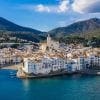
Immerse yourself in Cadaquès's vibrant flavors and uncover hidden culinary gems with our expert insider guides. Plan an unforgettable trip today!
Read more
Immerse yourself in Sitges's vibrant flavors and uncover hidden culinary gems with our expert insider guides. Plan an unforgettable trip today!
Read moreIf you would like us to customize an exclusive luxury tour, contact us and let us know your travel plans. We offer luxury food and wine tours for private groups of a mininium two guests. In addition, all of our private, chauffeured tours are available year-round upon request.

